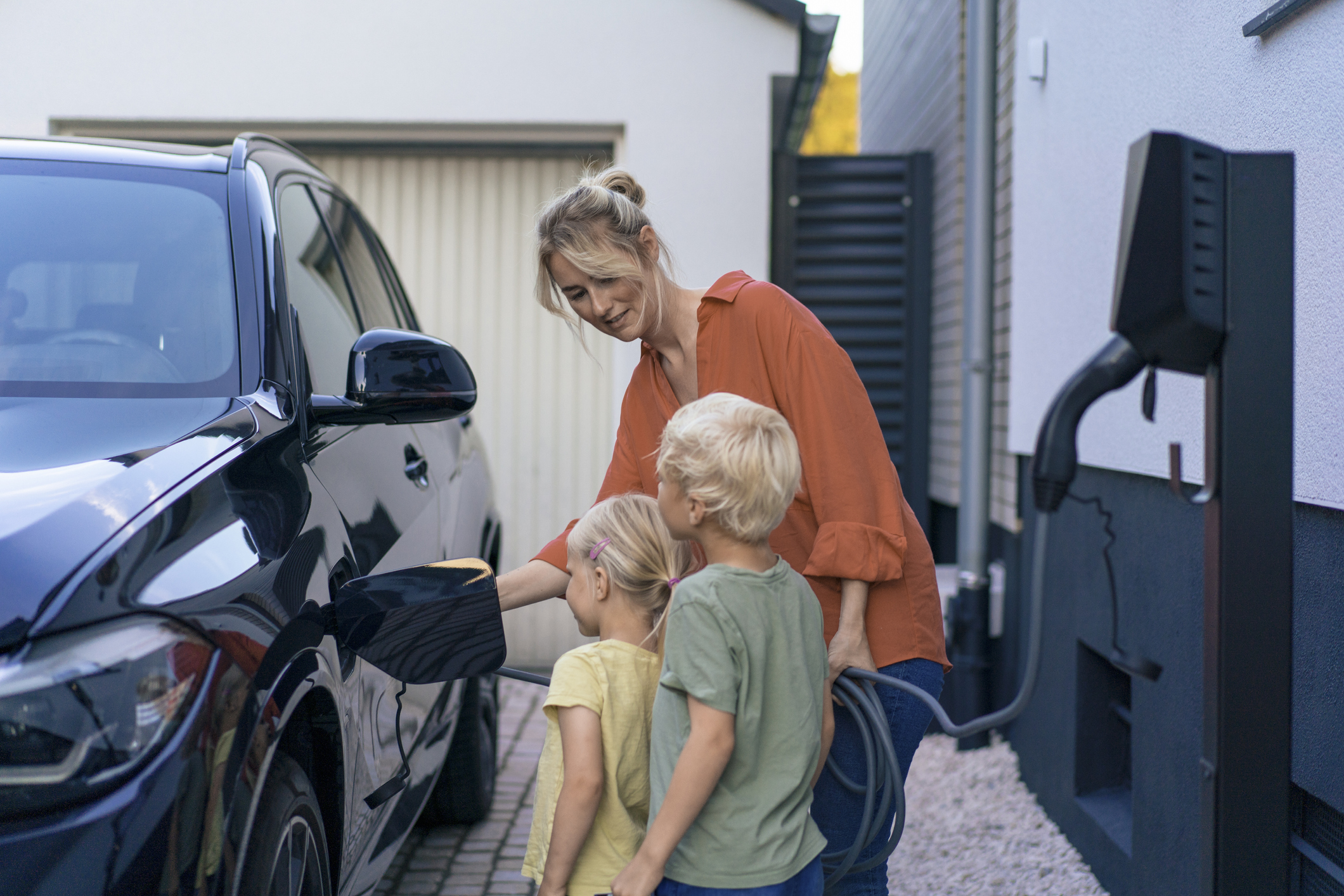Seven things you need to know before installing an electric vehicle charger
Charging your EV at home rather than relying on public charging points is convenient and could save you money. We run through what you need to know before installing one.


Electric vehicles are generally cheaper to run than petrol or diesel cars, and charging one at home rather than at public charging points could save you a significant amount of money.
Installing a charger on your driveway also makes it more convenient to run an electric vehicle, as you can charge it at any time, such as overnight or while you’re busy at home.
Driving an EV is becoming more popular: there are almost 1 million (975,000) fully electric cars on UK roads, and 590,000 plug-in hybrids, according to EV community ZapMap.
MoneyWeek
Subscribe to MoneyWeek today and get your first six magazine issues absolutely FREE

Sign up to Money Morning
Don't miss the latest investment and personal finances news, market analysis, plus money-saving tips with our free twice-daily newsletter
Don't miss the latest investment and personal finances news, market analysis, plus money-saving tips with our free twice-daily newsletter
This month will see Tesla's updated Model 3 saloon arrive in Britain, with a range of more than 400 miles on a single battery charge, making it one of the longest-range EVs on the market.
But while you may have got over the initial hurdle of deciding which electric car to buy, there are other issues to consider, such as how to finance the EV purchase, and whether to install a home charger.
Although you can use a regular UK three-pin socket to power up your EV at home, it is much slower than a dedicated chargepoint and may involve running charging cables from inside your home.
According to the Energy Saving Trust, these cables are not as safe, and should not be used as a long-term solution for home charging. Extension leads should also not be used for safety reasons.
The best option is to install your own EV charger, joining an estimated 680,000 home and workplace chargers across the country.
We explain everything you need to know before installing a home EV charger.
1. How much an EV charger and installation is likely to cost
Some dealerships offer a free charger and installation when you purchase a new vehicle from them.
This could potentially save you hundreds of pounds, but check carefully before accepting it. For example, not all EV electricity tariffs can be accessed by all chargers, so a free charger might not be best for long-term savings.
You should also check what features the charger has, the customer reviews and whether you like the design.
If you’re buying your own charger, options include the reasonably-priced and reliable WaEV (the WaEV-charge EV1 costs about £500) to premium products with high-end design features such as the Andersen A2 (from £1,199).
There are installation costs on top, which can vary depending on complexity and cable length.
If you’re buying an EV charger online, you’ll need to get a qualified electrician to fit it.
Alternatively, charger providers will often install them for a fee. Companies such as Smart Home Charge offer quotes for both the charger and installation, with costs starting from £897.
You can find more information about installations at The Electric Vehicle Consumer Code for Home Chargepoints (EVCC).
2. Choose the right EV electricity tariff to unlock further savings
While you probably know that EVs charged at home are cheaper to run than petrol and diesel cars, you may not realise the huge difference your electricity tariff can make.
It's important to do your research and not automatically stay with your existing energy provider.
There are generally two types of EV tariffs. The most common, and typically the cheapest, offers two electricity rates depending on the time of day, with much lower rates at night. This means you can charge your car – or run your dishwasher or washing machine – very cheaply overnight.
Single-rate tariffs, on the other hand, are where you pay the same discounted rate throughout the day because you have an EV.
It can be tricky to compare EV tariffs as they aren’t usually on comparison websites. Smart Home Charge has a Cost to Charge tool that can help you calculate savings.
For example, the Volkswagen ID 3 pro with a 10,000 annual mileage would cost £655 to run on the average UK electricity tariff of 28p per kWh. But it would cost just £175 with Intelligent Octopus Go, a difference of £480.
You will need a smart meter to access an EV energy tariff. You may also need a certain type of home charger. Some tariffs only cover electricity - so if you have gas at home, you’ll need a separate gas tariff.
3. Check your internet connection in the EV charger location
The original EV chargers were a step up from charging with a three-pin plug - just a cable that connected to the car and put electricity into it.
But now all home EV chargers are required to be “smart”, giving users a lot more visibility and control.
The chargers come with a smartphone app, allowing drivers to time their sessions and keep tabs on the cost.
Danny Morgan at Smart Home Charge comments: “Some also have 'boost' capabilities, meaning they can give you a fast, maximum charge when needed. Smart EV chargers need to have a strong internet connection, which can be your home wi-fi, a mobile signal or a combination of the two.”
4. Consider where to install the charger - and how to park your EV
Your EV's port could be on the front, rear or side of the vehicle, and ideally you'll park close to your charger. Check whether forward or reverse parking will work best.
The charger can be fitted anywhere on the property within reason. Morgan explains: “It needs to be mounted to a secure surface, but it doesn't have to be on the brick wall of a house. It can be a bespoke charging post on the driveway, for example. Though the longer the cable from the power supply to the charger, the more expensive the installation will be typically.”
You’ll also need to think about whether you want a tethered cable - which is attached to the charging point - or untethered, where you unplug it after charging.
“Tethered is popular as many feel it's more convenient, but untethered means you have more flexibility as you can buy whatever length of cable suits you,” notes Morgan. “It can come in particularly useful in a multi-EV household, so you can avoid having to move your vehicles around to get close to the charger, in a version of 'car tetris'.”
5. If you want to use solar power to run your car, you'll need the right charger
Using solar power to run your car is a great way to be even more environmentally friendly.
If you already have solar panels and want to use them to help power your EV, it's important to choose a compatible charger, such as the Hypervolt or Andersen A2.
If you’re thinking of solar panels in future, the Easee One could be a good choice as although it's a regular EV charger, there's the option of adding solar compatibility later.
6, Tenants need to check with their landlords
If you're renting and would like an EV charge point installed, the first step is to discuss it with your landlord and get their permission.
There’s an incentive for landlords to say yes, as they can currently get a grant towards installing an EV charge point at a residential property that they own.
They can claim 75% of the cost and installation of a charge point, up to £350.
7, Don’t have a driveway or garage? Here are your options
Some homeowners don’t have a driveway or garage and therefore park their EV on the street. If that's the case, you may be tempted to run a cable across the pavement to charge it, but you should check with your council first.
Local authorities have the power to remove any cables they think are in unsuitable locations, and some have issued statements advising that motorists should not do this.
Even if you think you can run a cable across the pavement, any issues such as pedestrians tripping and hurting themselves would be your legal responsibility.
Aside from using public charging points, there are potentially two ways around this. Kerbocharge installs a special pavement channel with a power line from your home. It needs local authority approval (which it requests on your behalf) and is currently running pilot schemes with Milton Keynes, Reading and Durham councils.
The other option is to borrow someone else’s home charger. The Co Charger app allows people to share their home charger with neighbours. The owner of the charger sets a price per hour, with a minimum amount per session. It’s typically much cheaper than using a public charger.
Get the latest financial news, insights and expert analysis from our award-winning MoneyWeek team, to help you understand what really matters when it comes to your finances.

Ruth is an award-winning financial journalist with more than 15 years' experience of working on national newspapers, websites and specialist magazines.
She is passionate about helping people feel more confident about their finances. She was previously editor of Times Money Mentor, and prior to that was deputy Money editor at The Sunday Times.
A multi-award winning journalist, Ruth started her career on a pensions magazine at the FT Group, and has also worked at Money Observer and Money Advice Service.
Outside of work, she is a mum to two young children, while also serving as a magistrate and an NHS volunteer.
-
 Boost for over 100,000 families on Child Benefit as new HMRC payment system rolled out
Boost for over 100,000 families on Child Benefit as new HMRC payment system rolled outThousands of households will no longer have to pay the dreaded High Income Child Benefit Charge through self-assessment
-
 Are you being haunted by the ghost of Christmas past? How festive cutbacks could boost your long-term wealth
Are you being haunted by the ghost of Christmas past? How festive cutbacks could boost your long-term wealthThe average family spends around £1,000 over the Christmas season. Here’s how much you could have gained if you had invested some of the money instead.